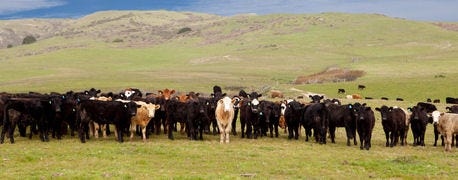
Based on surveys of cattle producers, USDA estimated the Jan. 1, 2015, all cattle and calves inventory at 89.8 million head, up 1.4% from a year ago. On average traders expected the herd to be down a fraction of a percent.
The beef cow herd, at 29.693 million head, is up just over 2% and about 1.5% larger than the trade expected. Heifers kept for beef replacements, at 5.777 million were up 4% and 1.4% more than the trade expected. Those numbers say producers are upping production at a faster pace than traders and the market had expected. That's bearish on prices.

Larger inventory is bearish; Cow-calf producers will likely face most pressure; More beef will come by late 2016 and into 2017.
Still 2015 beef production will be tight. Culling fewer cows and keeping more of them in the breeding herd, plus retaining more heifers for expansion, will trim slaughter numbers. Fed cattle have been coming to market at heavier weights. Higher slaughter and carcass weights will at least partially offset the smaller slaughter numbers, but likely not enough to up production much.
Two factors push feedlots to feed cattle to higher weights. One is squeaky-tight feeder cattle supplies. Empty pens make no money. When managers know finding feeder cattle to place will be a challenge and when they find them they'll be pricey, one way to up pen space utilization is to feed cattle longer. Another is cheaper feed. Cheaper is relative. Corn is cheaper than it was after the 2012 drought. But corn is well above its harvest 2014 low.
The dairy side of the cattle business is also expanding faster than traders expected. Faltering milk prices may press dairy farmers to scale back planned expansions.
Market share grabbers in action. Pricy beef gives both hog and chicken producers ample incentive to expand. Trade chatter points to 3% to 4% more broiler production in 2015.
Broiler prices will likely drift a bit lower as production rises. That means the price spread between beef and chicken will stay wide. The wide spread and lack of supply, can eventually push even die hard beef lovers to look elsewhere.
Hog producers stocked up on the breeding herd to help offset baby pig death losses due to PEDV. Now PEDV appears to be manageable. Pigs per litter seem likely to rebound. Hog slaughter weights seem unlikely to mark the 10 pound per head year-over-year hikes that they showed in the summer of 2014. But they are not likely ease much either. Hog slaughter could be up anywhere from 3.5% to 5% over 2014. Add a couple pounds of extra weight per head and a lot of pork is coming.
Chatter at this week's Iowa Pork Congress suggests that a lot more hogs are out there.
Key factors to watch >>
~~~PAGE_BREAK_HERE~~~
Key factors to watch. Years of hearing how bad animal fats are for our health have given way to maybe a little fat is not so bad after all. That's music to the ears of red meat protein lovers and producers. Watch for potential changes in dietary guidelines or fads and trends.
Despite wage rate stagnation, the U.S. economy is perking along at its best year since the great recession. Consumer incomes are up and so are tastes for meat.
The strong dollar makes our exports more expensive abroad. It also makes imports cheaper. Meat exports could ease and imports rise. Both would loosen the tight supply situation a bit. However, any major export disruption, such as the west coast dock workers' labor issues, could hammer exports.
Any way you slice it, cheap oil leaves the vast majority of consumers (those not involved in the energy sector) with more disposable consumer income.
Feed price shocks are possible, especially with soybeans. That's because bean stocks remain relatively tight. But corn stocks have surged. Corn would need a major production shortfall to push prices sharply higher.
The biggest factor for cattle herd expansion will remain weather as it affects 2015 grazing conditions.

About the Author(s)
You May Also Like




